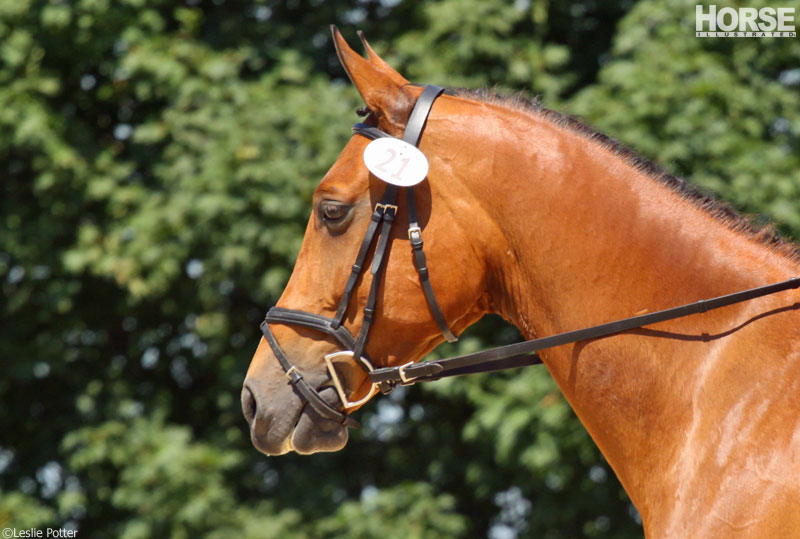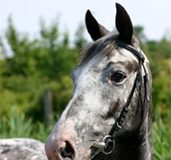In this age of social sharing, you may have encountered armchair experts offering their opinions on horse videos and photos across the Internet. But how much can a person really tell about a horse’s stress level just by watching? Researchers from England’s Nottingham Trent University sought to find out. They presented their findings at last week’s International Equitation Science Conference.

Perception vs. reality: Does a high head carriage and a nose in front of the vertical mean a horse is tense, or is he relaxed? Photo: Leslie Potter
Scientists separately analyzed the same footage, recording behavior indicators including the position and movement of the ears, head, neck and tail as well as head carriage and nose angle (in front of, at or behind the vertical.) The researchers measured eye temperature and cortisol, a hormone linked to stress, during each horse’s ridden test to determine the actual stress level.
Horses with a high head carriage were generally rated by professionals from all three professions as having high stress levels and those with a low head carriage were rated more positively. However, the stress indicators showed that the opposite was true. The instructors were the only group that gave an overall positive rating to horses with a neutral head carriage.
The instructors were also the only group to rate a vertical nose position positively. Overall, the professionals gave a negative assessment to horses that went with their nose ahead of the vertical, even though the FEI guidelines state that a horse’s nose should always be slightly in front of the vertical. The stress indicators back up those guidelines. Temperature increased with the duration of the nose carried behind the vertical and decreased when the nose was carried ahead of the vertical.
Although the study is preliminary and would require follow-ups for more information, it appears that even experienced professionals don’t always assess a horse’s demeanor correctly when evaluating a video. Keep that in mind the next time you see a harsh critique on YouTube.
In summary:
- Based on the cortisol levels, which are considered a measure of stress response, horses are more stressed when they carry their necks low than when they carry them high.
- Based on temperature measurements, horses are most stressed when they move with their nose position behind the vertical and least stressed when ahead of the vertical.
- Overall, equestrian professionals rate horses as appearing less stressed when they have a low head carriage, which runs counter to the evidence.
- Equestrian professionals also rate horses with their noses in front of the vertical as being more stressed, which is also counter to the evidence.
- Riding instructors’ assessments of the horses were a bit more accurate than the other two groups of professionals: professional riders and equine surgeons.
Assessing ridden horse behavior: Professional judgment and physiological measures. Hall, Carol et al. Journal of Veterinary Behavior: Clinical Applications and Research , Volume 9 , Issue 1 , 22 – 29 Published Online: December 02, 2013 DOI: https://dx.doi.org/10.1016/j.jveb.2013.09.005
Leslie Potter is the Senior Associate Web Editor for horseillustrated.com. Follow her on Twitter: @LeslieInLex






great info
I can see the higher stress level, with the lower head set, because that is so unnatural and it must be hard to care your head so low.
I hate the lower head set, especially in western riding. It’s so unnatural and yet it’s championed as a natural way of riding. Movement is clearly impeded by this position and obviously that would cause stress.
Interesting and not so surprising that the instructors came out on top!
I find it interesting that almost any discussion about stress and force with horses ends up with people discussing head and neck position, and totally ignores many other indicators such as,
strained or relaxed muscles
How the feet are moving,
Here is a blog with a few examples of horses that are stressed with high heads and low heads and relaxed horses with both high and low heads.
JMO, but any expert that relies only on head or neck position to make a point is not much of an expert.
http://behindthehorsestable.blogspot.com/2014/06/unwilling-horses-bad-riders-and-know-it.html
makes a ton od sense horses don’t go around with their noses behand the vertaial in paddocks, only when the stress of showing off might A horse arch the neck to passage for another horse and usually the nose is still in front of the vertical
I have found that if my horse aggressively takes his treat (or anything I offer him) with his mouth open wide and using his teeth he is stressed…. otherwise he is gentle using his lips and taking the offering slow and gentle
Research surveys are so subjective. This one in particular, which shows all the signs of being motivated/instigated by Hyperflexion enthusiasts! For use as defence ammunition in future anti-hyperflexion debates?
ok, let’s just clarify what you mean by low head carriage, because if when nose is in front of vertical, the stress is lower and when low head carriage stress is higher, it means that the low head carriage you mention is with nose behind the vertical, and THAT is not a natural posture, its a learned/forced one, and as such, will cause stress. You need to be more specific about study parameters.
Horse related studies in general are so far from being anything that even resembles proper scientific protocol that no wonder no credible results ever come out of them and only serve to generate even more controversy. If I believed in the conspiracy theory I would say it was on purpose, because I’m not sure the horse would would like to face the actual facts.
Jane- this research would actually support the anti-hyperflexion side of the debate. The horses with their noses behind the vertical (overflexed) were found to be more stressed, based on cortisol and temperature measurements.
Ana- head carriage and nose position were observed separately, so the head carriage isn’t necessarily related to whether the horse was in front of, at or behind the vertical.
If you’ve ridden an Arabian for any length of time and know them well, these findings will come as no surprise. Higher head carriage is not only genetic in terms of conformation, but also a sign of high spirits. Most people aren’t stressed when they’re having fun.
Is this only when ridden?
It makes sense the horse would be more stressed out when he is flexed in longitudal suppling, because horses can’t see where they are going when they are flexed like that. It’s harder for them to do it on a straight line too than on a circle. What line of travel was used in this experiment? I think perhaps there should be two experimental groups in the future where one group tests on a straight line and the other on a circle.